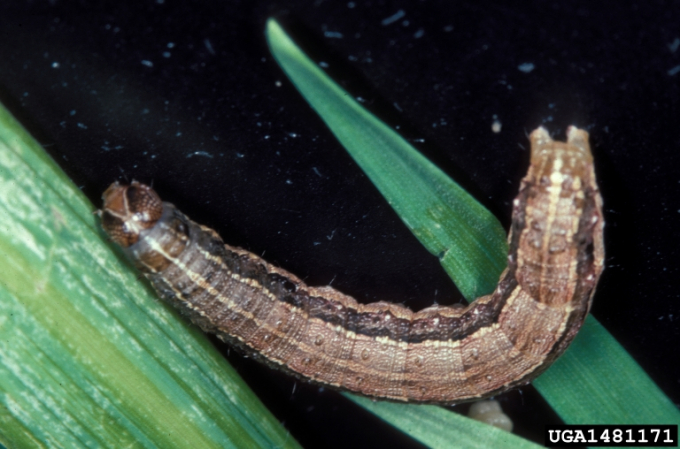May 21, 2025 | 08:05 GMT +7
May 21, 2025 | 08:05 GMT +7
Hotline: 0913.378.918
May 21, 2025 | 08:05 GMT +7
Hotline: 0913.378.918

Fall armyworms. Photo: Getty Image
Fall armyworms genetically modified to wipe out wild populations have been launched in corn fields in São Paulo State in Brazil in the primary farm trial of a brand new expertise for controlling the pests. The trial was successful and is now being expanded, says Oxitec, the UK-based firm that created the GM armyworms.
Fall armyworms (Spodoptera frugiperda) are in reality moth caterpillars. They get their title from the truth that they multiply very quick and feed on many crops. Swarms of armyworms can devastate all the pieces from lawns to crops in simply days.
Fall armyworms are native to the Americas however in latest years have unfold throughout Africa, Asia and Australia, decreasing harvests by as much as half. Conventional management strategies usually are not working nicely as a result of some strains have advanced resistance to many pesticides.
“There is a lot of interest in new solutions to this pest,” says Neil Morrison of Oxitec. “Growers are struggling to control it through insecticidal means.”
Oxitec took a pressure that’s nonetheless vulnerable to pesticides and modified it in order that feminine offspring can survive solely in the presence of a particular chemical. In different phrases, the males carry a gene that kills all feminine offspring in the wild.
When modified male fall armyworms are launched, they mate with wild females. Only male offspring survive, and so they can mate and unfold the female-killing gene to a different technology. Unlike with pesticides, no different species are harmed.
If no extra “Friendly™” fall armyworms”, as Oxitec calls them, are launched, the female-killing genes quickly disappear from the wild inhabitants. If giant sufficient numbers of GM males are launched, wild armyworms will be worn out domestically.
That’s the idea, not less than. Future trials will consider effectiveness, says Morrison. The preliminary farm trial was solely meant to check whether or not the launched males behave as anticipated.
“For instance, after we stop releasing, does the self-limiting gene disappear from the environment? Yes it does,” he says.
The method already has the mandatory approvals in Brazil. “We can deploy those Friendly males anywhere in Brazil without restriction,” Morrison says.
Oxitec is already promoting “Friendly™ Aedes aegypti” mosquitoes in Brazil to forestall the unfold of ailments resembling Zika and dengue. On 8 March, it received the go-ahead for pilot initiatives in California and Florida.
The fall armyworm (Spodoptera frugiperda) is a species in the order Lepidoptera and one of the species of the fall armyworm moths distinguished by their larval life stage. The term "armyworm" can refer to several species, often describing the large-scale invasive behavior of the species' larval stage. It is regarded as a pest and can damage and destroy a wide variety of crops, which causes large economic damage. Its scientific name derives from frugiperda, which is Latin for lost fruit, named because of the species' ability to destroy crops. Because of its propensity for destruction, the fall armyworm's habits and possibilities for crop protection have been studied in depth. It is also a notable case for studying sympatric speciation, as it appears to be diverging into two species currently.Another remarkable trait of the larva is that they consistently practice cannibalism, despite its fitness costs.
The fall armyworm is active at a different time of year from the true armyworm, another species in the order Lepidoptera and family Noctuidae, but of the genus Mythimna. Outbreaks of the true armyworm usually occur during the early part of the summer; the fall armyworm does most damage in the late summer in the southern part of the United States, and early fall in the northern regions.
Adults are capable of flying long distances, so even though they are unable to overwinter north of the southern region of the United States, the moths can migrate as far north as southern Canada in warm months. Their migration rate is remarkably fast, estimated at 300 miles (483 km) per generation. Some scientists speculate that this fast migration is aided by the movement of air in weather fronts.
(Newscientist)

(VAN) Attempts to bring down the price of the Japanese staple have had little effect amid a cost-of-living crisis.

(VAN) Fourth most important food crop in peril as Latin America and Caribbean suffer from slow-onset climate disaster.

(VAN) Shifting market dynamics and the noise around new legislation has propelled Trouw Nutrition’s research around early life nutrition in poultry. Today, it continues to be a key area of research.

(VAN) India is concerned about its food security and the livelihoods of its farmers if more US food imports are allowed.

(VAN) FAO's Director-General emphasises the need to work together to transform agrifood systems.

(VAN) Europe is facing its worst outbreak of foot-and-mouth since the start of the century.

(VAN) The central authorities, in early April, released a 10-year plan for rural vitalization.